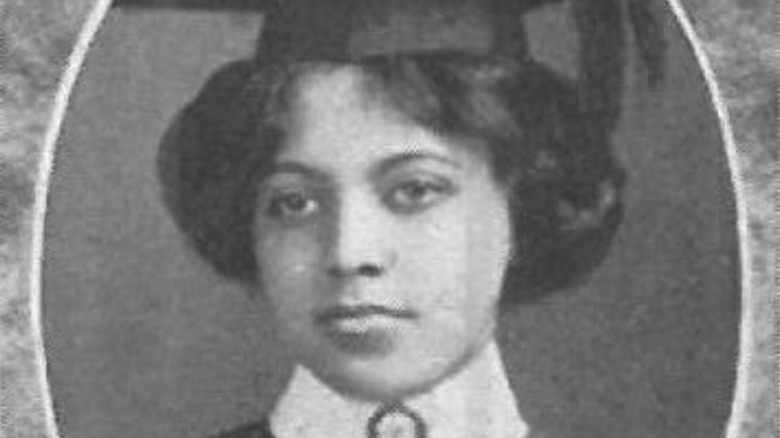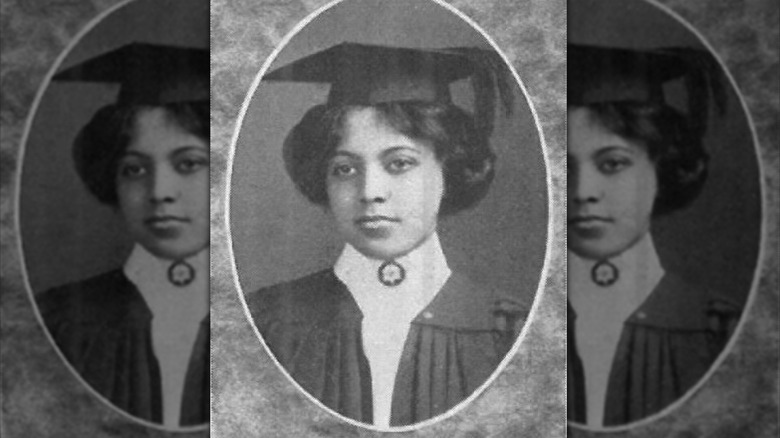How A Man Got All The Credit For Alice Ball's Work
You may have heard the phrase "women in STEM" bouncing around on TikTok, seen it in the occasional Twitter meme, or watched it wrongly portrayed on "The Big Bang Theory." If you're not a woman in STEM yourself, then you might not know the actual significance behind the term.
The truth is, STEM fields — science, technology, engineering, and math — have not been kind to women. Not only are female graduates and workers severely underrepresented in these fields, according to STEM Women, but social and cultural norms also impact women's choices to pursue these disciplines (via Best Colleges). The lack of role models, specifically those of color, is one factor mentioned by AAUW that can perpetuate the STEM gender bias. The thing is, while women have been excluded from these professions throughout history, their historical contributions have also been overlooked.
Alice Ball, a 20th-century chemist, is one example of a historic STEM figure whose scientific research was nearly lost to the past (via University of Hawai'i Foundation). She joins the ranks of women like Edmonia Lewis, who were nearly erased from history because of their race and gender. As a Black woman in the 1910s, her work was easily taken credit for by others, which would not be formally recognized for decades.
Alice Ball's contribution to leprosy treatment
Alice Ball began making history when she became the first woman and the first African American to graduate from the College of Hawaii, now known as the University of Hawaii, in 1915 (via University of Hawai'i Foundation). After earning two degrees from the University of Washington, one in pharmaceutical chemistry and the other in pharmacy, according to Scientific Women, Ball then studied chemistry in Hawaii, with her thesis centered around identifying and extracting the active chemical in kawa roots. In 1915, Ball became the university's first female chemist instructor at age 23, another historical feat. Working in both a research and teaching capacity, she was recruited as a researcher by Harry T. Hollmann in 1916 (via National Geographic).
Hollmann worked at Kalihi Hospital, a facility that treated leprosy, and hoped to find an effective treatment for his patients. At the time, chaulmoogra oil was being utilized in leprosy treatments, but its natural form — used topically, ingested orally, or inserted intravenously — produced unfortunate side effects. Hollmann hoped that, with Ball's help, they could discover a more effective method that utilized the oil's active components. In less than a year, the chemist determined how to create an injectable, water-soluble solution from the chaulmoogra oil's active components (via Biography). The injections created from this method of component isolation were the preferred form of leprosy treatment until the 1940s, saving thousands of lives.
Unfortunately, Ball would not receive credit for this work for many years.
Recognizing Alice Ball's work
Alice Ball became ill in the fall of 1916, likely from accidental chemical poisoning, which prompted her to return to her home state of Washington, per National Geographic. She died on December 31st, 1916, at the age of 24.
Unable to publish her findings before her death, Ball's work was taken over by the chemist Arthur L. Dean. It was under his control that the method of component isolation, which he named after himself, became a popular form of leprosy treatment (via Scientific Women). Harry T. Hollmann published a research article detailing Ball's findings, but the University of Hawaii did not recognize her work for decades. The publication, though, would help researchers piece together the true story of the leprosy treatment years later, allowing Ball to be officially recognized for her scientific contributions.
According to "African American Women Chemists" by Jeannette Brown, the survival of Ball's accomplishments can be attributed to Dr. Kathryn Takara, a professor who began researching Black women in Hawaii in 1977, and Stanley Ali, a retired federal worker who was doing similar research. The college has since honored Ball in many ways, including hanging a bronze plaque in front of the campus's chaulmoogra tree in her honor in 2000 and awarding her with the Regents' Medal of Distinction in 2007 (via Biography). February 29th was also declared "Alice Ball Day" by the former Litenuent Governor. In 2017, Paul Wermager, another scholar from the university, established "The Alice Augusta Ball" scholarship.


